
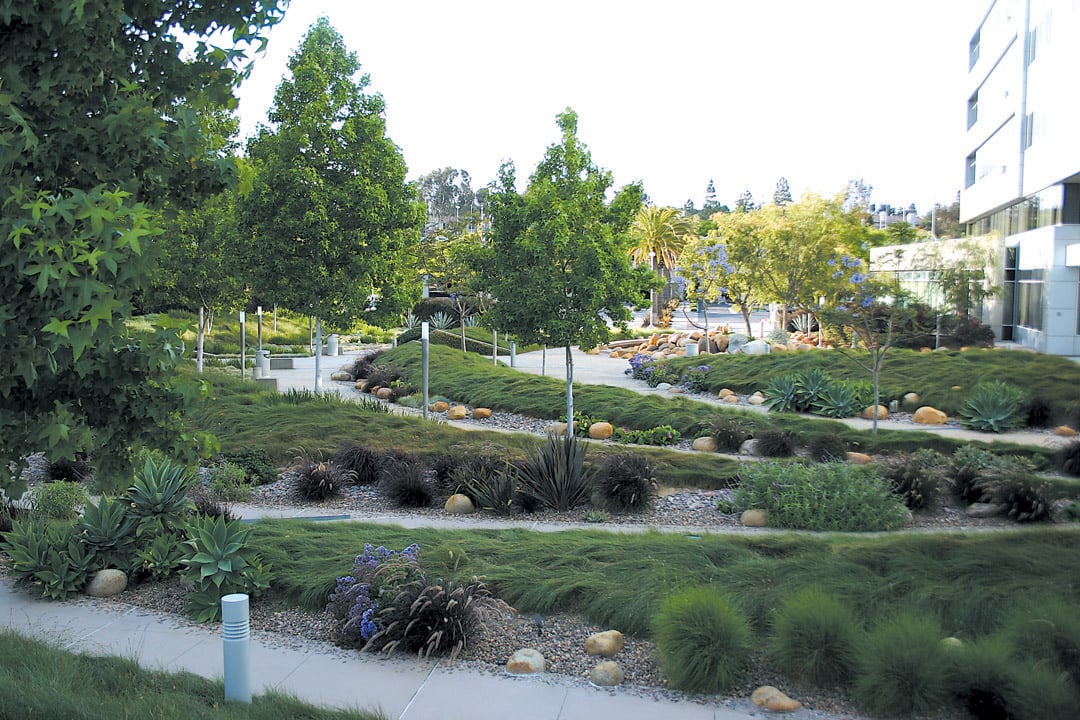
Contributor
- Topics: Archive
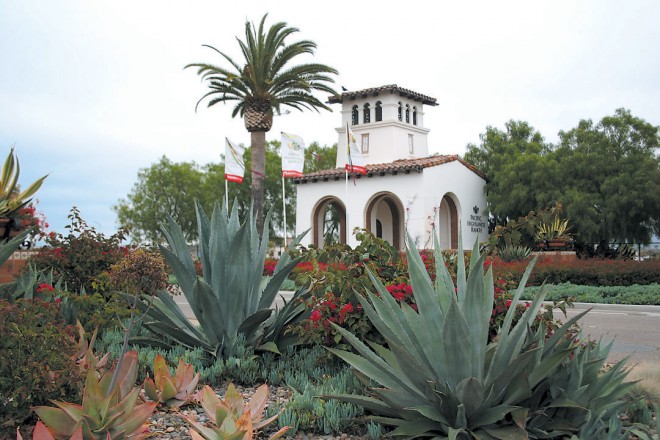
Whenever I fly into San Diego’s Lindbergh Field airport, I cringe. It isn’t the flying that bothers me; it’s the airport landscape that screams, “Welcome to San Diego, home of rolling grass and tropical palms!” No wonder new arrivals want their gardens to look like the tropics.
San Diego is not tropical. In our almost desert-dry, mediterranean climate, the only native palm is the Washingtonia filifera, which is native to desert seeps.
For much of my professional life, my goal has been to transform California’s planted landscapes, from overly thirsty and resource-intensive to climate-appropriate and sustainable. I talk about it, teach about it, write about it, and—okay, I’ll admit—rant about it. I’m not the only person with this goal, of course; many of my garden design and communications colleagues feel the same way. So do many of California’s water agencies; some try to stimulate change with watering restrictions and rate increases. A few cutting-edge agencies fund model residential landscapes, but they rarely get the public exposure necessary for a sea change.
People emulate the landscapes they see around them. When all they see is “tropicalissimo,” as at the San Diego airport, all they know to ask for is “tropicalissimo.” I constantly wonder, though, if the public were to see beautiful, low-water landscapes every day, everywhere they went, wouldn’t they emulate those kinds of gardens instead?
What we need are beautiful, sustainable, low-water landscapes in public spaces like streetscapes and shopping centers, and around office buildings, schools, and hospitals. Over the last few years, I’ve noticed some movement in that direction. Here are three of the region’s best examples.
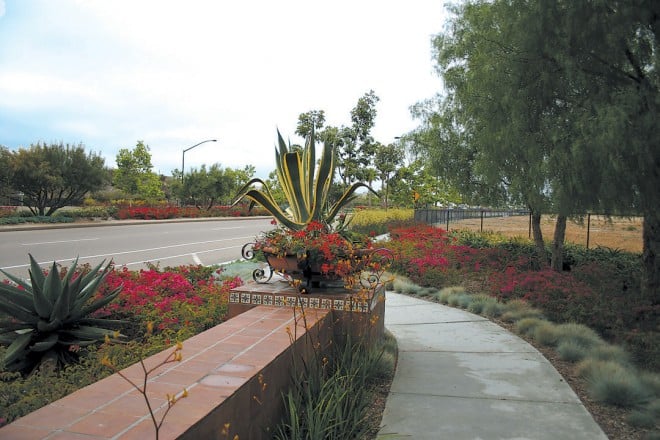
Pacific Highlands Ranch
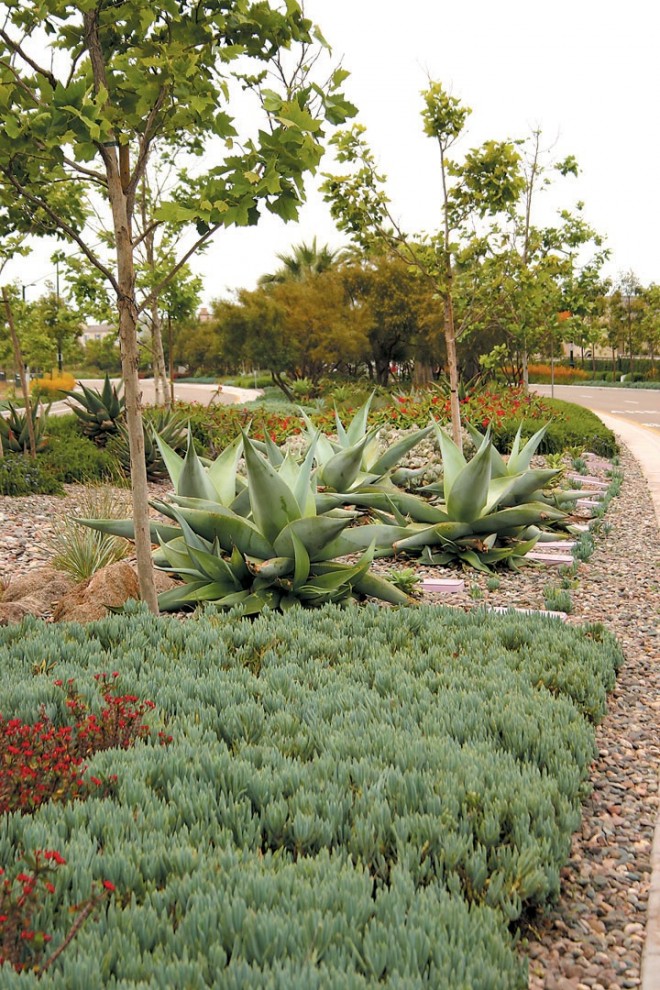
San Diego’s Carmel Valley lies between the communities of La Jolla and Del Mar. Once a rural valley with horse ranches, tomato fields, and scrub-covered hillsides, Carmel Valley is now home to nearly 37,000 people, along with offices, hotels, shopping centers, and schools. Much of the valley is planted like San Diego’s airport. Pacific Highlands Ranch, however, offers a different aesthetic. This Pardee Homes development was landscaped in 2005 with the goal of creating something attractive and drought tolerant, with year-round interest and little or no turf.
A pair of tile-roofed gatehouses flanks the entry to Pacific Highlands—a nod to the Spanish Revival architecture so popular in the region’s past. Landscape architects Smithgall Johnston Associates, Inc, assembled a plant palette that offers a variety of flowering seasons, textures, and colors. The center median and parkways are lush with hybrid palms (Washingtonia), mounds of red Bougainvillea ‘La Jolla’, sweeps of succulent blue chalk sticks (Senecio mandraliscae), and clumps of blue fescue (Festuca glauca). Elegant blue Agave americana and variegated A. americana ‘Marginata’ rise from terra cotta pots, some elevated for architectural drama.
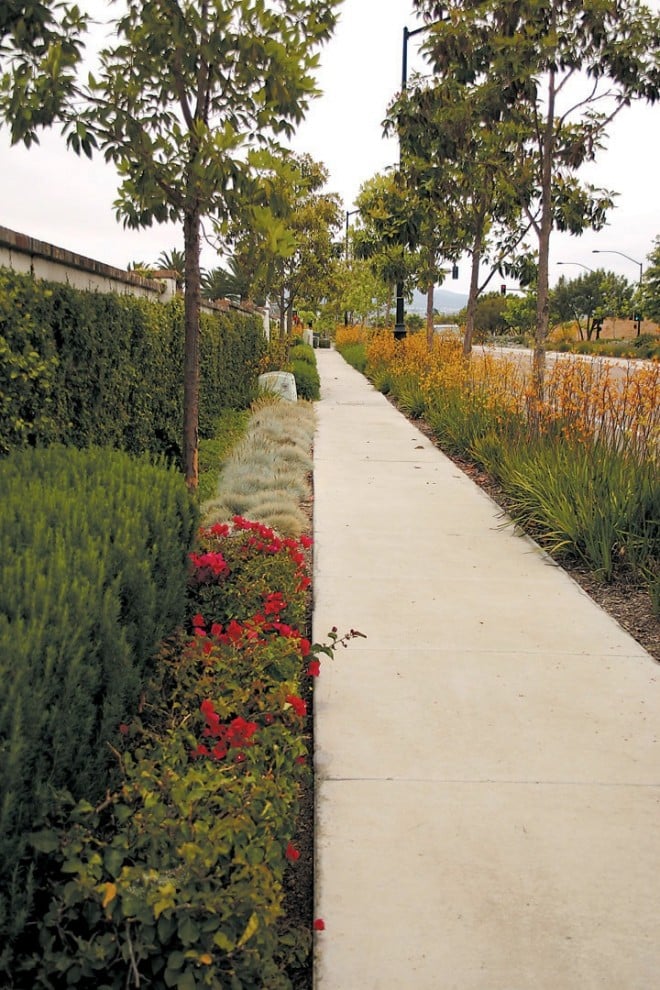
Beyond the gatehouses, the mile-and-a-half-long center median suggests a cobble-filled dry streambed, bordered by layered and inter-woven drifts of plants, all beneath a canopy of African sumac (Rhus lancea), London plane (Platanus xacerifolia ‘Bloodgood’), and Brisbane box (Lophostemon confertus). The understory includes at least three types of agave (Agave guiengola, A. americana, and A. geminiflora) planted in geometric blocks. Aloe marlothii and A. arborescens flower in mid-winter. The pink blossoms of crown-of-thorns (Euphorbia milii ‘Jerry’s Choice’) echo the pink-margined, blue gray leaves of succulent Cotyledon orbiculata ‘Silver Dollar’. Vast swaths of desert spoon (Dasylirion wheeleri) are a knockout.
Reclaimed water supplements the natural rainfall. Larger median trees are irrigated with bubblers; understory plants are drip irrigated, using Octa-bubblers set below the surface and protected in valve boxes. Water use is about half that of “conventional” streetscapes.
Pathways are somewhat more lush and pedestrian friendly. Creeping fig (Ficus pumila) crawls up block walls that separate public walks from private spaces. Masses of upright rosemary (Rosmarinus officinalis) are underplanted with blue chalk sticks. Other blocks are filled with kangaroo paws (Anigozanthos ‘Harmony’), their tall red stems topped in fuzzy, bright yellow flowers. Prostrate rosemary (R. officinalis ‘Prostratus’) fills the spaces between sidewalk and curb.
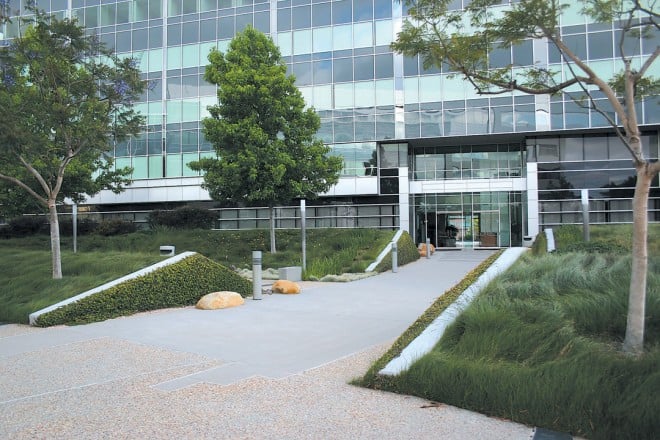
Kilroy Center
Also in Carmel Valley is Kilroy Center, a complex of five office buildings, sheathed in aqua blue mirrored glass, that covers twelve acres of land beside the freeway. Its businesses and medical offices are always abuzz with people coming and going.
Kilroy’s parking lot entrance is what first caught my eye. Yes, there are the requisite palm trees, but they are underplanted with rosettes of coral aloe (Aloe striata), tall New Zealand flax (Phormium), and several types of wispy ornamental grasses. Shaded parking lot islands featured masses of Bergenia alternating with tufts of blue fescue beneath jacaranda trees (Jacaranda mimosifolia), and all mulched in river-washed gravel. The design really shines in the courtyards, where I was surprised to see sweeping beds of Agave americana, New Zealand tea tree (Leptospermum scoparium), dune sedge (Carex pansa), Salvia clevelandii, and other plants uncommon in a commercial landscape.

Landscape architect Kathy Garcia, now planning and community development director for the City of Del Mar, designed the landscape when she was at the firm of Wallace Roberts & Todd. According to Garcia, the property’s owners “wanted something distinctive to set them apart from the typical corporate campus.” Her firm jumped at the opportunity to “promote more of a sustainable palette, more indicative of California, rather than lawn and the Northeastern sensibility that, unfortunately, so many clients want.”
In early 2000, Garcia began playing with an abstraction of the way water once flowed though the river valley. She thought about how rocks in a stream cause ripples in the water. The buildings became conceptual rocks, the arcs of landscaped beds the resulting ripples. Those ripples are most obvious from the offices above, or from the dune sedge-covered berms at the rear of each courtyard. The berms serve as a green background, while blocking noise from the freeway where, today, cars flow in place of water.
Each courtyard is unique, but plantings are clearly thematic. Vast meadows of dune sedge are edged in swaths of red fountain grass (Pennisetum setaceum ‘Rubrum’) and Atlas fescue (Festuca mairei). Large blue Agave americana, upright rosemary, and clumps of fortnight lily (Dietes iridioides) punctuate “seas” of blue fescue and giant wild rye (Leymus condensatus ‘Canyon Prince’). Australian willows (Geijera parvifolia), jacarandas, and liquidambars (Liquidambar styraciflua) form soft canopies overhead.
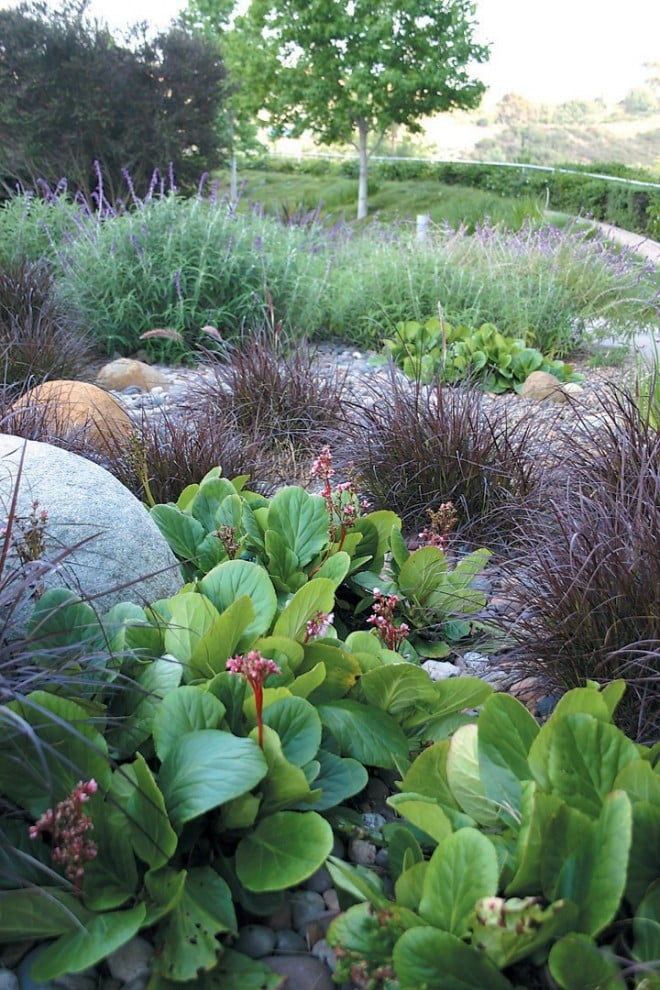
Initially, some of the ripples were planted in turf for a sea-of-green look. Over time, several have been replanted with Dymondia margaretae, which needs far less water. Rocks and pebbles are an important design motif throughout. A shallow, arcshaped pond suggests lushness, a common device in Mediterranean landscapes.
Garcia remembers how the original landscape maintenance crew butchered plants; she had to wrestle with them to allow the agaves to pup and not to prune the tea trees into little balls. The crews also struggled with the irrigation zoning to keep plants from being overwatered.
Landsystems, the current landscape maintenance company, takes an entirely different approach. Operations manager Matt Shaffer says that crews work with the seasonality of the landscape. They develop healthy soils, allow dormant grasses to turn wheat-colored, and trim the sedge with hand-held shears rather than mowers it. In parking islands and other areas, overhead irrigation has been converted to an in-line drip system. Today, Shaffer says, water use is about half of what he sees in more typical commercial landscapes.
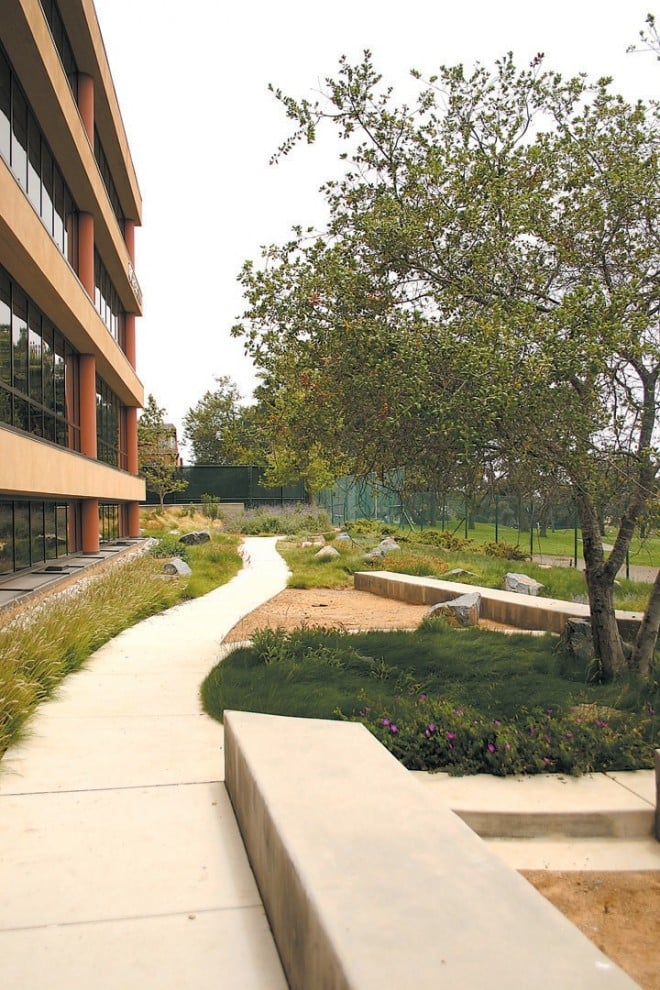
Torrey Pines Court
Further west lies Torrey Pines Court, a twenty-acre site overlooking Torrey Pines Golf Course. Its original 1980s landscape featured “water-sucking” coral trees, tree ferns, daylily, pigmy date palms, and acres of lawn. In the mid-2000s, the Muller Company purchased the property and hired landscape architect Mike Sullivan, of SiteDesign Studio, to renovate the landscape and rework an oddly configured parking lot. Sullivan’s personal goal was to design something sustainable, water conserving, and evocative of California’s foothills and grasslands.
Sullivan divided the campus into several “habitats:” ornamental borders, woodlands, and meadowy grasslands. Years earlier, Sullivan had introduced John Greenlee to the idea of using planted grasslands or meadows in designed landscapes. Today, Greenlee is a leader in that movement.
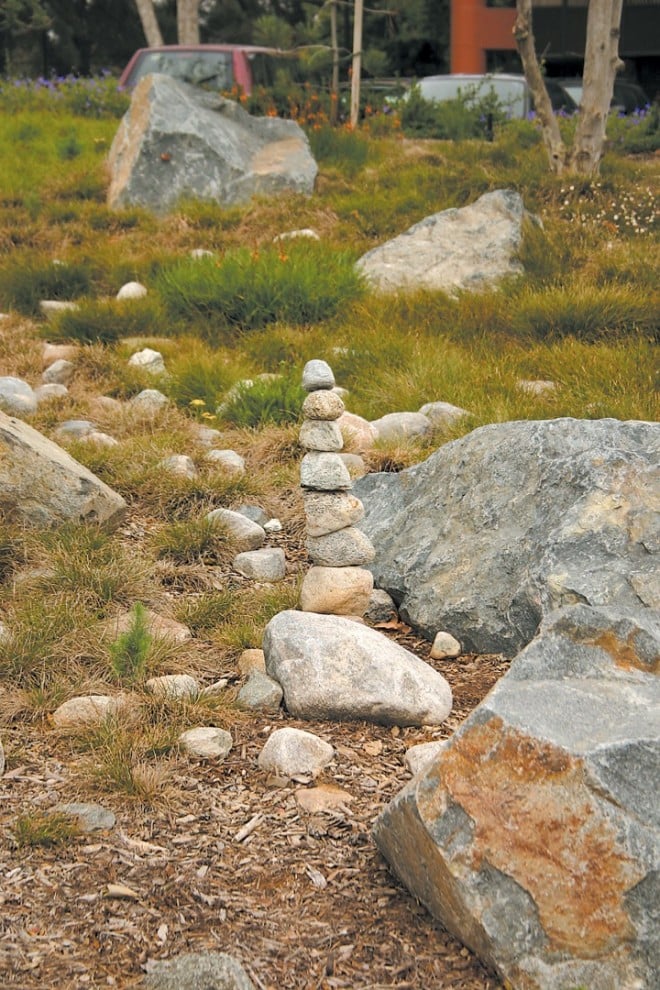
As he considered his design, Sullivan kept in mind that “this is a campus of buildings with people walking back and forth. I wanted to make it like walking through a natural area . . . reminiscent of the Sierra.” Sullivan sculpted the terrain into undulating landforms, incorporating boulders and cobble. He planted grassland tapestries on the slopes, using a mix of sedges (Carex pansa, C. remota, C. texensis, and C. tumulicola). Into these, he incorporated purple-flowering catmint (Nepeta xfassenii), succulent orange Bulbine ‘Hallmark’, Iris douglasiana, creamy yellow yarrow (Achillea ‘Hoffnung’), and blue violet Geranium ‘Johnson’s Blue’.
Nearer the buildings and in areas with higher foot traffic, Sullivan used larger scaled grasses, such as Calamagrostis xacutiflora ‘Overdam’ and ‘Karl Foerster’. More colorful plants are featured in higher visibility areas: red Penstemon ‘Firebird,’ ‘Orange Cross’ kangaroo paws, orange-flowered lion’s tail (Leonotis leonurus), violet Salvia clevelandii, and melon-colored LIVIN’ EASY roses that were salvaged from the previous landscape.

Among the larger shrubs are strawberry tree (Arbutus unedo) and natives such as toyon (Heteromeles arbutifolia) and Arctostaphylos ‘Howard McMinn’. Coast live oak (Quercus agrifolia) and California sycamore (Platanus racemosa) were obvious choices for trees, along with Torrey pines (Pinus torreyana), to link with Torrey Pines State Park just a down the road.
The landscape is irrigated with reclaimed water, mostly by overhead sprinklers, but the plants require about a third less than more conventional landscapes, according to Robert Allgaier, landscape supervisor for Park West Companies, the maintenance contractor. Maintenance time is about the same as for other landscapes, but the Park West crew spends it differently. “Drought-tolerant plants look great if left natural,” Allgaier says; “no balling or boxing whatsoever. That means less maintenance on that scale and more time to spend on details.” The details include keeping planter beds well defined and using hand tools to maintain separations between the plants, yet leaving them as natural as possible.
Allgaier says the biggest adjustment is education. “Some owners want their landscapes to be lush and plush. Drought tolerant plants may not always look lush.” There’s a learning curve involved for everyone. In terms of the crew, Allgaier continues, “some plants here are considered weeds in other landscapes. The crew has to learn the distinctions, but when they [the plants] are planted in masses, the crew catch on quickly.”
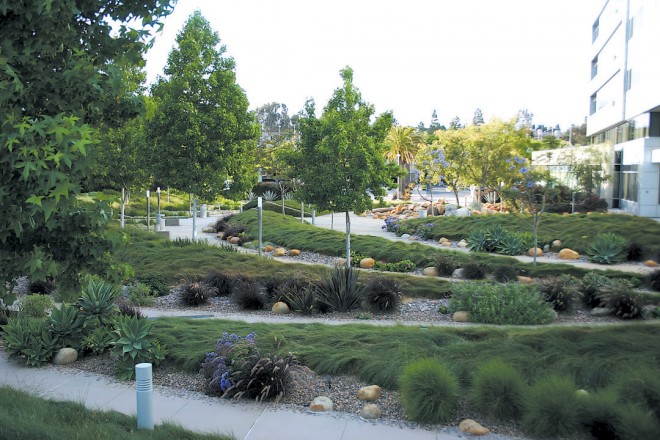
Allgaier would love to see more landscapes like Torrey Pines Court; in fact, Park West is now using plants from this project in others. “I love the meadows and vast open areas rather than tight planters next to buildings,” he says. “I like the uniqueness of Torrey Pines Court. Granted, in winter, vines are bare and there are no major blooms. But, you know that right around the corner is spring, when everything will pop and it’s going to be beautiful.”
That subtle seasonality, fitting plants to the climate and the site, a plant palette beyond tropical palms and rolling lawns, thoughtful and wise irrigation methods . . . these are what we so desperately need people to see. As landscapes like these become more visible and commonplace, the public’s perceptions will change so that homeowners and hotel owners alike will recognize low-water landscapes as beautiful and desirable. More than merely suiting California, these landscapes define us and allow us to garden into our future.
Share:
Social Media
Garden Futurist Podcast
Most Popular
Videos
Topics
Related Posts

Ground Up Science for Greener Cities with Garden Futurist Dr. Alessandro Ossola
Spring 2023 Listen to the Podcast here. Alessandro Ossola is a scientist who gets very excited about the challenge of climate change allowing for an

Readying Urban Forests for Climate Realities with Garden Futurist Dr. Greg McPherson
Winter 2023 Listen to the Podcast here. “Going from the mow and blow to a more horticulturally knowledgeable approach to maintaining the landscape. And that

Low Maintenance Gardens – Better for Pollinators and People
Autumn 2022 “I come out every day. It’s therapy, my meditation.” Janet’s young garden transformed from overgrown, invasive plants to mostly natives. The dailiness of

Invasive Plants Are Still Being Sold: Preventing Noxious Weeds in Your Landscape
Autumn 2022 With so many beautiful ornamental plant species and cultivars throughout California and the Pacific Northwest, how do you decide which ones to include










Responses